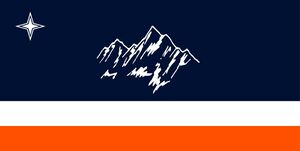Verastia Territory
| Verastia Territory Skírēn Verastia | |
 Flag | |
| Country | |
| Theme | |
| Capital | Green Boots |
| Population | 102,632 |
| Chief Executive | Ádrama Korelin |
| President | Tiwodrus Masakraviluv |
| Legislature | Legislative Conference |
| Stanora seats | 1 |
| Official languages | Coscivian |
| Postal Abbreviation | VRS |
| Time Zone | Valēka Standard Time |
Verastia Territory (Kiravic: Skírēn Verastia) is a territory of the Kiravian Federacy located in the Western Highlands of Great Kirav. It has the highest average elevation of any federal subject, and encompasses the island continent’s tallest mountain, Mount Xýzyro, for which it is not named. The rugged terrain, high altitude, and extreme weather have left Verastia sparsely populated and constrained its economic development.
Government
The Governor of Verastia is appointed by the Prime Executive of the Kiravian Federacy every five years, and presides over an Executive Council to which they appoint members with the confirmation of the Legislative Conference.
The Legislative Conference comprises 20 seats, to which legislators are elected by [voting system(s)] every [term]. The territory does not currently recognise political parties, and procedures for registering new parties were discontinued in 21194. As such, all candidates for the Legislative conference stand as independents. The Kirosocialist Party of Verastia remains registered (but unrecognised) under the old laws, but functions mainly as a social club and does not contest elections.
The Verastia Territorial Police are the territory’s sole law enforcement agency, as countyships and municipalities do not field their own police forces. Due to budgetary constraints and the high costs of policing Verastia’s sparse population and difficult terrain, the VTP relies on support from the Federal Police for many functions, including forensics and aviation.
Verastia’s territorial defence force, the Verastian Rangers, serves mainly civil defence and emergency management purposes. The territory has no air defence units of its own.
Law
Like many federal subjects in the Western Highlands, Verastia Territory has rather lax regulations on the ownership, bearing, and transfer of firearms, stemming from the fact that most Verastians view guns as a survival tool and necessary household appliance.
Society & Culture
The population of Verastia Territory is estimated to be 54% Urom, 44% Coscivian, and 2% Celtic. A large percentage of the Coscivian population is of partial Urom descent, and a smaller (but still significant) percentage of the “urbanised” Urom population has Coscivian ancestry. Due to the strongly patrilocal and patrilineal nature of Coscivian culture, mixed persons with Coscivian fathers are considered Coscivians themselves, whereas those with Urom fathers are not. As such, there are some Verastians of predominantly Urom descent who consider themselves Coscivians and are accepted as such. Doubts have been raised as to how effective the Kiravian Census has been at enumerating the Urom population, as many Urom settlements are remote, reclusive, difficult to access due to terrain and/or weather, or even uncharted.
The largest Urom group, the Ankhul, are indigenous to the territory’s lower elevations, traditionally inhabiting the Shalluk Valley and its larger side-valleys. Because their territory includes the areas most heavily colonised by Coscivians, Ankhul form the bulk of the “urban” Urom population, and most of the mixed population is of Ankhul descent. The Lishku tribe...
A small, isolated band of Urom may be living near a small, extremely inaccessible glacial lake in the Northwest Countyship, according to three eyewitness reports from helicopter pilots who flew through the vicinity during the 21170s. If so, these Urom would be the last remaining uncontacted people in Great Kirav. The Federal Land Administration, which owns the land, has since instituted a moratorium on helicopter flights through the area, which was already off-limits to visitors for safety reasons.
The Yeti population of Verastia is unknown, but estimated to be somewhere between 10 and 50. Only 2 Verastia residents listed their ethnicity as Yeti on the 21200 census.
Verastia is one of the few federal subjects where Christians are a minority. The Coscivian population is 55% Christian, 31% affiliated with Coscivian religions, and 14% of other persuasions, including deism, ietsism, and nontheistic worldviews. Just under half of the enumerated Urom population is Christian (~90% Catholic and ~10% Reformed Orthodox), with the rest recorded under codes P-88 “Northwest Highlands Urom Orolatry” or P-90X “Urom Beliefs - Not Otherwise Specified”, or as having no religion in particular. The unenumerated Urom population is assumed to hold indigenous beliefs. In the decades before Kirosocialism, the Catholic Church dispatched numerous missions to Verastia, heralded in the Catholic press as an effort to convert Great Kirav’s “Last Pagan Territory”. In 21149 the Kirosocialist government began limiting civilian travel to Verastia, effectively ending the missions. Even though missionary activity resumed after 21166, new missions have been met with limited success.
Economy

Verastia Territory has a small economy based mainly on tourism and subsistence activities such as small-scale farming, hunting, and fishing. Many residents, especially the Urom population, live isolated and premodern lifestyles largely disconnected from the wider Kiravian economy.
The tourist industry caters to hikers, skiers, mountain climbers, and sightseers who come to enjoy the territory’s mountainous landscape, with Mount Xýzyro as the main attraction.
